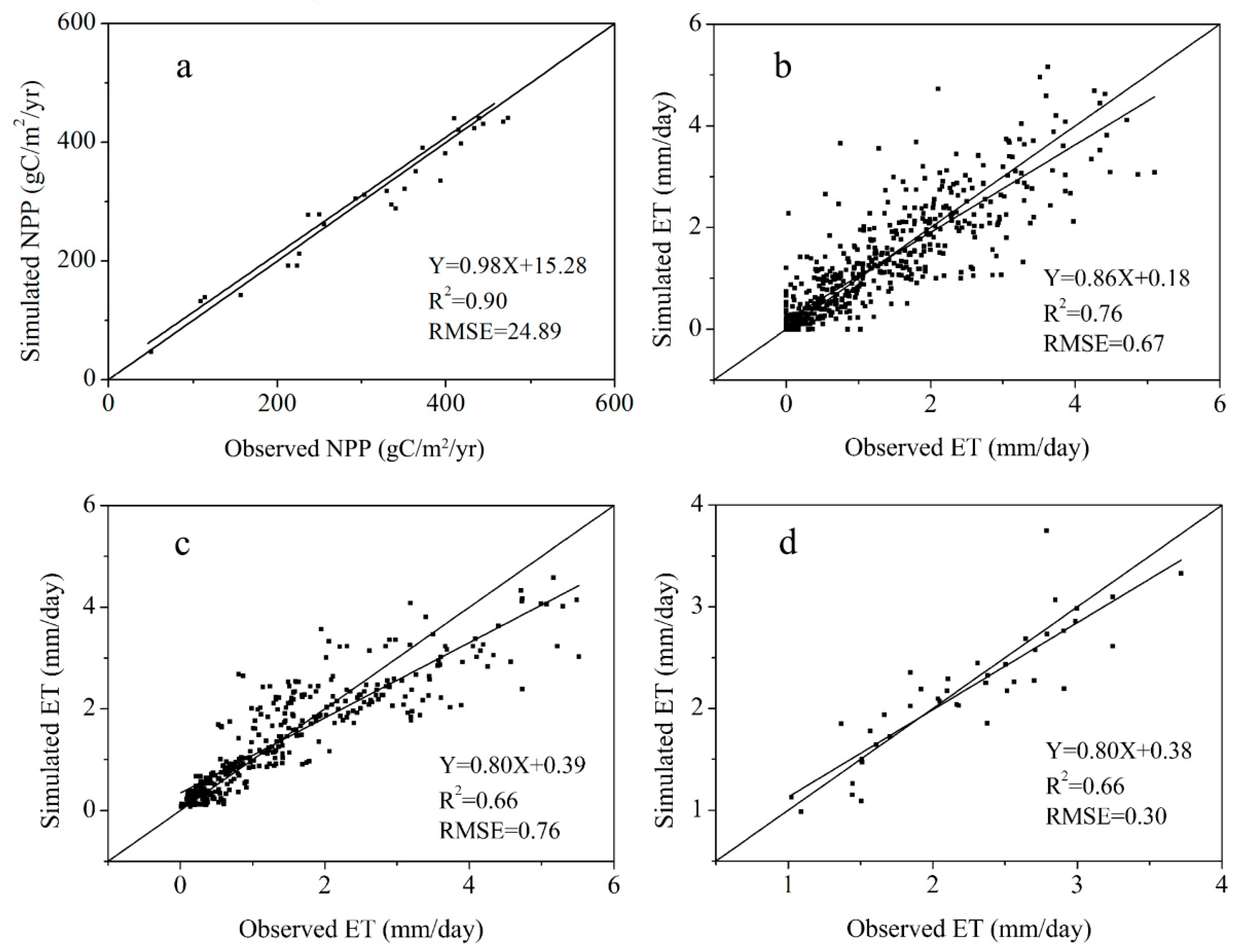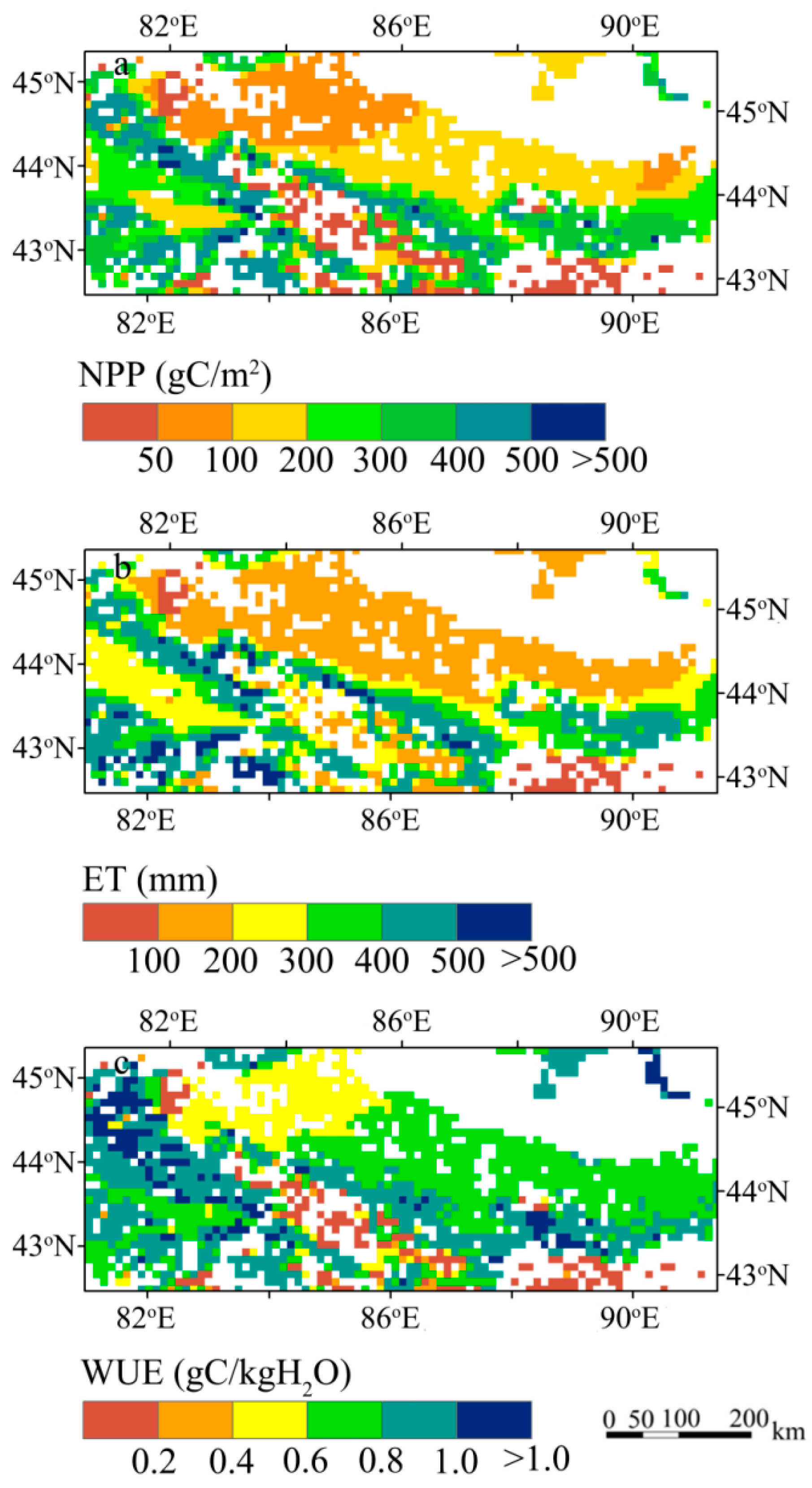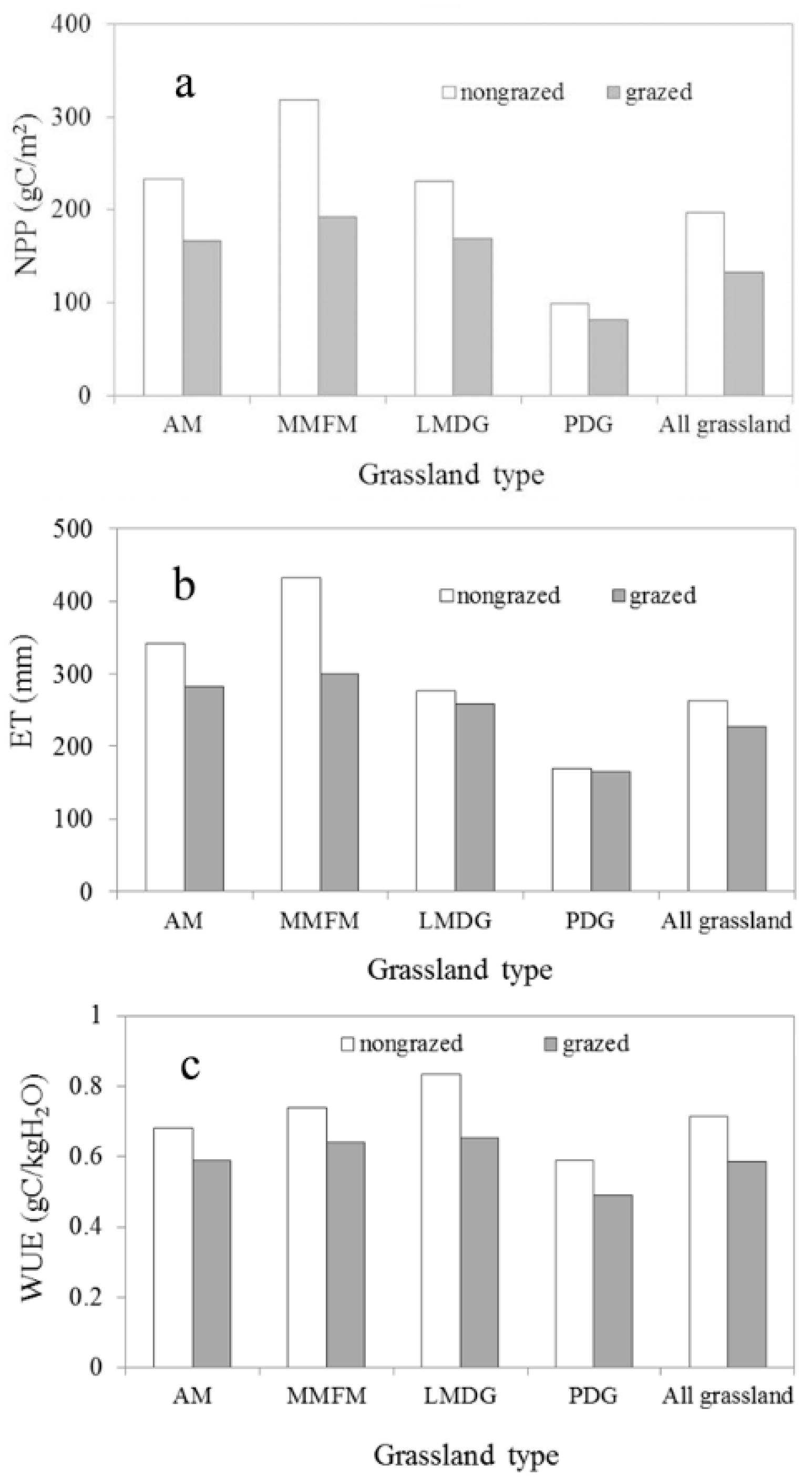Ecological Effects of Grazing in the Northern Tianshan Mountains
Abstract
:1. Introduction
2. Study Materials and Methods
2.1. Study Area
2.2. Methods
2.3. Data
2.3.1. Meteorological Data
2.3.2. Ecophysiological Parameters
2.3.3. Soil and Elevation Data
2.3.4. Grazing Data
2.3.5. ET and NPP Validation Data
3. Results
3.1. Model Validation
3.2. Spatial Variations in NPP, ET and WUE in Ungrazed Grasslands
3.3. Differences between Grazed and Ungrazed Grasslands
3.3.1. Temporal Variations in Grassland NPP, ET and WUE
3.3.2. Spatial Patterns of Differences in NPP, ET and WUE under Grazing and Ungrazed Scenarios
4. Discussion
4.1. Effects of Grazing on Grassland NPP, ET and WUE
4.2. Comparison to Previous Studies
5. Conclusions
Acknowledgments
Author Contributions
Conflicts of Interest
References
- Abdalla, K.; Chivenge, P.; Everson, C.; Mathieu, O.; Thevenot, M.; Chaplot, V. Long-term annual burning of grassland increases CO2 emissions from soils. Geoderma 2016, 282, 80–86. [Google Scholar] [CrossRef]
- Trepekli, A.; Loupa, G.; Rapsomanikis, S. Seasonal evapotranspiration, energy fluxes and turbulence variance characteristics of a Mediterranean coastal grassland. Agric. For. Meteorol. 2016, 226, 13–27. [Google Scholar] [CrossRef]
- Liu, X.Y.; Long, R.J.; Shang, Z. Evaluation method of ecological services function and their value for grassland ecosystems. Acta Pratacult. Sin. 2011, 20, 167–174. [Google Scholar]
- Eichelmann, E.; Wagner-Riddle, C.; Warland, J.; Deen, B.; Voroney, P. Evapotranspiration, water use efficiency, and energy partitioning of a mature switchgrass stand. Agric. For. Meteorol. 2016, 217, 108–119. [Google Scholar] [CrossRef]
- Li, S.-G.; Asanuma, J.; Kotani, A.; Davaa, G.; Oyunbaatar, D. Evapotranspiration from a Mongolian steppe under grazing and its environmental constraints. J. Hydrol. 2007, 333, 133–143. [Google Scholar] [CrossRef]
- Davis, S.C.; Burkle, L.A.; Cross, W.F.; Cutting, K.A. The effects of timing of grazing on plant and arthropod communities in high-elevation grasslands. PLoS ONE 2014, 9, e110460. [Google Scholar] [CrossRef] [PubMed]
- Yan, L.; Zhou, G.S.; Zhang, F. Effects of different grazing intensities on grassland production in China: A meta-analysis. PLoS ONE 2013, 8, e81466. [Google Scholar] [CrossRef] [PubMed]
- Luo, G.P.; Han, Q.F.; Zhou, D.C.; Li, L.; Chen, X.; Li, Y.; Hu, Y.K.; Li, B.L. Moderate grazing can promote aboveground primary production of grassland under water stress. Ecol. Complex. 2012, 11, 126–136. [Google Scholar] [CrossRef]
- Jin, J.X. Xinjiang Yearbook, 1st ed.; China Statistics Press: Beijing, China, 2012.
- Zhao, W.Y.; Li, J.L.; Qi, J.G. Changes in vegetation diversity and structure in response to heavy grazing pressure in the northern Tianshan Mountains, China. J. Arid Environ. 2007, 68, 465–479. [Google Scholar] [CrossRef]
- Liu, H.; Zang, R.G.; Chen, H.Y.H. Effects of grazing on photosynthetic features and soil respiration of rangelands in the Tianshan Mountains of northwest China. Sci. Rep. 2016, 6, 30087. [Google Scholar] [CrossRef] [PubMed]
- Gu, A.X.; Fan, Y.M.; Wu, H.Q.; Zhu, J.Z.; Jin, G.L.; Reziw, A. Relationship between the number of three main microorganisms and the soil environment of degraded grassland on the north slope of the Tianshan Mountains. Acta Pratacult. Sin. 2010, 19, 116–123. [Google Scholar]
- He, G.X.; Li, K.H.; Liu, X.J.; Gong, Y.M.; Hu, Y.K. Fluxes of methane, carbon dioxide and nitrous oxide in an alpine wetland and an alpine grassland of the Tianshan Mountains, China. J. Arid Land 2014, 6, 717–724. [Google Scholar] [CrossRef]
- Han, Q.F.; Luo, G.P.; Li, C.F.; Xu, W.Q. Modeling the grazing effect on dry grassland carbon cycling with biome-bgc model. Ecol. Complex. 2014, 17, 149–157. [Google Scholar] [CrossRef]
- Liu, W.B.; Wang, L.; Zhou, J.; Li, Y.Z.; Sun, F.B.; Fu, G.B.; Li, X.P.; Sang, Y.F. A worldwide evaluation of basin-scale evapotranspiration estimates against the water balance method. J. Hydrol. 2016, 538, 82–95. [Google Scholar] [CrossRef]
- Wang, K.C.; Dickinson, R.E. A review of global terrestrial evapotranspiration: Observation, modeling, climatology, and climatic variability. Rev. Geophys. 2012, 50, RG2005. [Google Scholar] [CrossRef]
- Niu, S.L.; Xing, X.R.; Zhang, Z.; Xia, J.Y.; Zhou, X.H.; Song, B.; Li, L.H.; Wan, S.Q. Water-use efficiency in response to climate change: From leaf to ecosystem in a temperate steppe. Glob. Chang. Biol. 2011, 17, 1073–1082. [Google Scholar] [CrossRef]
- Zhang, T.; Peng, J.; Liang, W.; Yang, Y.T.; Liu, Y.X. Spatial-temporal patterns of water use efficiency and climate controls in China’s Loess Plateau during 2000–2010. Sci. Total Environ. 2016, 565, 105–122. [Google Scholar] [CrossRef] [PubMed]
- Gaigalis, V.; Skema, R. A review on solid biofuel usage in Lithuania after the decommission of ignalina NPP and compliance with the EU policy. Renew. Sustain. Energy Rev. 2016, 54, 974–988. [Google Scholar] [CrossRef]
- Kool, D.; Agam, N.; Lazarovitch, N.; Heitman, J.L.; Sauer, T.J.; Ben-Gal, A. A review of approaches for evapotranspiration partitioning. Agric. For. Meteorol. 2014, 184, 56–70. [Google Scholar] [CrossRef]
- Medrano, H.; Tomas, M.; Martorell, S.; Escalona, J.M.; Pou, A.; Fuentes, S.; Flexas, J.; Bota, J. Improving water use efficiency of vineyards in semi-arid regions. A review. Agron. Sustain. Dev. 2015, 35, 499–517. [Google Scholar] [CrossRef]
- Han, Q.F.; Luo, G.P.; Li, C.F.; Ye, H.; Chen, Y.L. Modeling grassland net primary productivity and water-use efficiency along an elevational gradient of the northern Tianshan Mountains. J. Arid Land 2013, 5, 354–365. [Google Scholar] [CrossRef]
- Chen, X.; Li, B.L.; Li, Q.; Li, J.L.; Abdulla, S. Spatio-temporal pattern and changes of evapotranspiration in arid central Asia and Xinjiang of China. J. Arid Land 2012, 4, 105–112. [Google Scholar] [CrossRef]
- Derner, J.D.; Boutton, T.W.; Briske, D.D. Grazing and ecosystem carbon storage in the north American great Plains. Plant Soil 2006, 280, 77–90. [Google Scholar] [CrossRef]
- Mikola, J.; Setala, H.; Virkajarvi, P.; Saarijarvi, K.; Ilmarinen, K.; Voigt, W.; Vestberg, M. Defoliation and patchy nutrient return drive grazing effects on plant and soil properties in a dairy cow pasture. Ecol. Monogr. 2009, 79, 221–244. [Google Scholar] [CrossRef]
- Milchunas, D.G.; Lauenroth, W.K. Quantitative effects of grazing on vegetation and soils over a global range of environments. Ecol. Monogr. 1993, 63, 327–366. [Google Scholar] [CrossRef]
- Schuman, G.E.; Reeder, J.D.; Manley, J.T.; Hart, R.H.; Manley, W.A. Impact of grazing management on the carbon and nitrogen balance of a mixed-grass rangeland. Ecol. Appl. 1999, 9, 65–71. [Google Scholar] [CrossRef]
- Eldridge, D.J.; Poore, A.G.B.; Ruiz-Colmenero, M.; Letnic, M.; Soliveres, S. Ecosystem structure, function, and composition in rangelands are negatively affected by livestock grazing. Ecol. Appl. 2016, 26, 1273–1283. [Google Scholar] [CrossRef] [PubMed] [Green Version]
- Kimuyu, D.M.; Sensenig, R.L.; Riginos, C.; Veblen, K.E.; Young, T.P. Native and domestic browsers and grazers reduce fuels, fire temperatures, and acacia ant mortality in an African savanna. Ecol. Appl. 2014, 24, 741–749. [Google Scholar] [CrossRef] [PubMed]
- Bresloff, C.J.; Nguyen, U.; Glenn, E.P.; Waugh, J.; Nagler, P.L. Effects of grazing on leaf area index, fractional cover and evapotranspiration by a desert phreatophyte community at a former uranium mill site on the Colorado Plateau. J. Environ. Manag. 2013, 114, 92–104. [Google Scholar] [CrossRef] [PubMed]
- Miao, H.; Chen, S.; Chen, J.; Zhang, W.; Zhang, P.; Wei, L.; Han, X.; Lin, G. Cultivation and grazing altered evapotranspiration and dynamics in Inner Mongolia steppes. Agric. For. Meteorol. 2009, 149, 1810–1819. [Google Scholar] [CrossRef]
- Wu, H.L. Evapotranspiration estimation of platycladus orientalis in northern China based on various models. J. For. Res.-Jpn. 2016, 27, 871–878. [Google Scholar] [CrossRef]
- Baldocchi, D.D. Assessing the eddy covariance technique for evaluating carbon dioxide exchange rates of ecosystems: Past, present and future. Glob. Chang. Biol. 2003, 9, 479–492. [Google Scholar] [CrossRef]
- Gurney, K.R.; Law, R.M.; Denning, A.S.; Rayner, P.J.; Baker, D.; Bousquet, P.; Bruhwiler, L.; Chen, Y.H.; Ciais, P.; Fan, S.; et al. Towards robust regional estimates of CO2 sources and sinks using atmospheric transport models. Nature 2002, 415, 626–630. [Google Scholar] [CrossRef] [PubMed]
- Dorigo, W.A.; Zurita-Milla, R.; de Wit, A.J.W.; Brazile, J.; Singh, R.; Schaepman, M.E. A review on reflective remote sensing and data assimilation techniques for enhanced agroecosystem modeling. Int. J. Appl. Earth Obs. Geoinf. 2007, 9, 165–193. [Google Scholar] [CrossRef]
- Zhang, Y.L.; Song, C.H.; Sun, G.; Band, L.E.; McNulty, S.; Noormets, A.; Zhang, Q.F.; Zhang, Z.Q. Development of a coupled carbon and water model for estimating global gross primary productivity and evapotranspiration based on eddy flux and remote sensing data. Agric. For. Meteorol. 2016, 223, 116–131. [Google Scholar] [CrossRef]
- Li, Z.; Yang, D.W.; Hong, Y. Multi-scale evaluation of high-resolution multi-sensor blended global precipitation products over the Yangtze River. J. Hydrol. 2013, 500, 157–169. [Google Scholar] [CrossRef]
- Laniak, G.F.; Olchin, G.; Goodall, J.; Voinov, A.; Hill, M.; Glynn, P.; Whelan, G.; Geller, G.; Quinn, N.; Blind, M.; et al. Integrated environmental modeling: A vision and roadmap for the future. Environ. Model. Softw. 2013, 39, 3–23. [Google Scholar] [CrossRef] [Green Version]
- Wang, Q.X.; Masataka, W.; Zhu, O.Y. Simulation of water and carbon fluxes using BIOME-BGC model over crops in China. Agric. For. Meteorol. 2005, 131, 209–224. [Google Scholar] [CrossRef]
- Xu, L.; Guo, P.; Liu, L.; Wang, L. Analysis of the spatiotemporal features of land use and land degradation in the northern Piedmont area of the Tianshan Mountains. Res. Soil Water Conserv. 2014, 21, 316–321. [Google Scholar]
- Seligman, N.G.; Cavagnaro, J.B.; Horno, M.E. Simulation of defoliation effects on primary production of a warm-season, semiarid perennial-species grassland. Ecol. Model. 1992, 60, 45–61. [Google Scholar] [CrossRef]
- Zhao, L.W.; Zhao, W.Z. Evapotranspiration of an oasis-desert transition zone in the middle stream of Heihe River, northwest China. J. Arid Land 2014, 6, 529–539. [Google Scholar] [CrossRef]
- Running, S.W.; Coughlan, J.C. A general-model of forest ecosystem processes for regional applications. 1. Hydrologic balance, canopy gas-exchange and primary production processes. Ecol. Model. 1988, 42, 125–154. [Google Scholar] [CrossRef]
- Hijmans, R.J.; Cameron, S.E.; Parra, J.L.; Jones, P.G.; Jarvis, A. Very high resolution interpolated climate surfaces for global land areas. Int. J. Climatol. 2005, 25, 1965–1978. [Google Scholar] [CrossRef]
- Raj, R.; Hamm, N.A.S.; van der Tol, C.; Stein, A. Variance-based sensitivity analysis of BIOME-BGC for gross and net primary production. Ecol. Model. 2014, 292, 26–36. [Google Scholar] [CrossRef]
- Yan, R.; Xiong, H.; Zhang, F. The evapotranspiration and energy budget of an Achnatherum splendens grassland in the oasis-desert ecotone in Xinjiang, China, during summer and autumn. J. Desert Res. 2013, 33, 133–140. [Google Scholar]
- Han, Q.; Luo, G.; Li, C.; Shakir, A.; Wu, M.; Saidov, A. Simulated grazing effects on carbon emission in central Asia. Agric. For. Meteorol. 2016, 216, 203–214. [Google Scholar] [CrossRef]
- Neff, J.C.; Reynolds, R.L.; Belnap, J.; Lamothe, P. Multi-decadal impacts of grazing on soil physical and biogeochemical properties in southeast Utah. Ecol. Appl. 2005, 15, 87–95. [Google Scholar] [CrossRef]
- Bell, L.W.; Kirkegaard, J.A.; Swan, A.; Hunt, J.R.; Huth, N.I.; Fettell, N.A. Impacts of soil damage by grazing livestock on crop productivity. Soil Tillage Res. 2011, 113, 19–29. [Google Scholar] [CrossRef]
- Teague, W.R.; Dowhower, S.L.; Baker, S.A.; Haile, N.; DeLaune, P.B.; Conover, D.M. Grazing management impacts on vegetation, soil biota and soil chemical, physical and hydrological properties in tall grass prairie. Agric. Ecosyst. Environ. 2011, 141, 310–322. [Google Scholar] [CrossRef]
- Agrawal, A.A. Overcompensation of plants in response to herbivory and the by-product benefits of mutualism. Trends Plant Sci. 2000, 5, 309–313. [Google Scholar] [CrossRef]
- Bremer, D.J.; Auen, L.M.; Ham, J.M.; Owensby, C.E. Evapotranspiration in a prairie ecosystem: Effects of grazing by cattle. Agron. J. 2001, 93, 338–348. [Google Scholar] [CrossRef]
- Olejniczak, P. Overcompensation in response to simulated herbivory in the perennial herb sedum maximum. Plant Ecol. 2011, 212, 1927–1935. [Google Scholar] [CrossRef]
- Paige, K.N. Overcompensation in response to mammalian herbivory: From mutualistic to antagonistic interactions. Ecology 1992, 73, 2076–2085. [Google Scholar] [CrossRef]
- Guo, S.; Yang, G.; Li, Q.; Zhao, C. Observation and estimation of the evapotranspiration of alpine meadow in the upper reaches of the Aksu River, Xinjiang. J. Glaciol. Geocryol. 2015, 37, 241–248. [Google Scholar]
- Leriche, H.; LeRoux, X.; Gignoux, J.; Tuzet, A.; Fritz, H.; Abbadie, L.; Loreau, M. Which functional processes control the short-term effect of grazing on net primary production in grasslands? Oecologia 2001, 129, 114–124. [Google Scholar] [CrossRef] [PubMed]
- Holland, E.A.; Parton, W.J.; Detling, J.K.; Coppock, D.L. Physiological-responses of plant-populations to herbivory and their consequences for ecosystem nutrient flow. Am. Nat. 1992, 140, 685–706. [Google Scholar] [CrossRef] [PubMed]
- Yang, D.F.; Gang, C.C.; MU, S.J.; Zhang, C.B.; Zhou, W.; Li, J.L. Analysis of the spatio-temporal variation in net primary productivity of grassland during the past 10 years in Xinjiang. Acta Pratacult. Sin. 2014, 23, 33–50. [Google Scholar]







| Location | Grassland Type | Validation Data (ET and NPP) | Meteorological Data | GRAZING Data | Soil Texture (Sand/Silt/Clay Percentages) | Elevation Data |
|---|---|---|---|---|---|---|
| Urumqi | LMDG | Daily ET (July 2012–December 2015) | Actual observations | Visiting herdsmen | Field investigations and laboratory analysis | Field investigations |
| Qitai | PDG | Daily ET (July 22–September 2, 2010) [40] | Actual observations | Visiting herdsmen | Field investigations and laboratory analysis | Field investigations |
| Aksu | AM | Daily ET (October 2012–September 2013) | Actual observations | Visiting herdsmen | Field investigations and laboratory analysis | Field investigations |
| Annual NPP obtained from a previous publication [14] and actual observations | Actual observations | Visiting herdsmen | Field investigations and laboratory analysis | Field investigations | ||
| Northern Tianshan Mountain grasslands | China Meteorological Forcing Data set (http://dam.itpcas.ac.c-n/chs/rs/?q=data) | GLIS (http://www.fao.org/A-G/againfo/resources/en/-glw/GLW_dens.html) (corrected based on statistical data from Xinjiang Yearbook [9] and field investigation by visiting some herdsmen) | HWSD (http://westdc.we-stgis.ac.cn/data/611f7d5-0-b419-4d14-b4dd-4a94-4b141175) | WorldClim (http://www.wo-rldclim.org/) [44] |
| Parameters | PDG | LMDG | MMFM | AM |
|---|---|---|---|---|
| Yearday to start new growth | 80 ** | 85 ** | 100 ** | 112 ** |
| Yearday to end litterfall | 310 ** | 317 ** | 300 ** | 270 ** |
| Transfer growth period as a fraction of the growing season | 0.35 | 0.35 | 0.35 | 0.35 |
| Litterfall as a fraction of the growing season | 0.35 | 0.35 | 0.35 | 0.35 |
| Annual leaf and fine root turnover fraction | 1 | 1 | 1 | 1 |
| Annual whole-plant mortality fraction | 0.1 | 0.1 | 0.1 | 0.1 |
| New fine root C: new leaf C | 4 ** | 3 ** | 2 ** | 2.5 ** |
| C:N of leaves (kg C/kg N) | 23.57 | 23.57 | 23.57 | 23.57 |
| C:N of leaf litter after retranslocation proportion is accounted for (kg C/kg N) | 41.44 | 41.44 | 41.44 | 41.44 |
| C:N of fine roots (kg C/kg N) | 46.36 | 46.36 | 46.36 | 46.36 |
| Leaf litter labile proportion | 0.39 | 0.39 | 0.39 | 0.39 |
| Leaf litter cellulose proportion | 0.44 | 0.44 | 0.44 | 0.44 |
| Leaf litter lignin proportion | 0.17 | 0.17 | 0.17 | 0.17 |
| Fine root labile proportion | 0.30 | 0.30 | 0.30 | 0.30 |
| Fine root cellulose proportion | 0.45 | 0.45 | 0.45 | 0.45 |
| Fine root lignin proportion | 0.25 | 0.25 | 0.25 | 0.25 |
| Canopy water interception coefficient (1/LAI/d) | 0.021 | 0.021 | 0.021 | 0.021 |
| Canopy light extinction coefficient | 0.6 | 0.6 | 0.6 | 0.6 |
| All-sided to projected leaf area ratio | 2 | 2 | 2 | 2 |
| Average specific leaf area of the canopy (projected on an area basis) (m2/kg C) | 12.5 ** | 12 ** | 30 ** | 25** |
| Ratio of shaded specific leaf area: sunlit specific leaf area | 2 | 2 | 2 | 2 |
| Fraction of leaf N in RuBisCO | 0.15 | 0.15 | 0.15 | 0.15 |
| Maximum stomatal conductance (projected on an area basis) (m/s) | 0.006 | 0.006 | 0.006 | 0.006 |
| Cuticular conductance (projected on an area basis) (m/s) | 0.00006 | 0.00006 | 0.00006 | 0.00006 |
| Boundary layer conductance (projected on an area basis) (m/s) | 0.04 | 0.04 | 0.04 | 0.04 |
| Leaf water potential: start of conductance reduction (MPa) | −0.73 | −0.73 | −0.73 | −0.73 |
| Leaf water potential: completion of conductance reduction (MPa) | −2.7 | −2.7 | −2.7 | −2.7 |
| Vapor pressure deficit: start of conductance reduction (Pa) | 1250 | 1250 | 1250 | 1250 |
| Vapor pressure deficit: completion of conductance reduction (Pa) | 5725 | 5725 | 5725 | 5725 |
| Variable | AM | MMFM | LMDG | PDG | All Grasslands |
|---|---|---|---|---|---|
| NPP (gC/m2) | 232.76 ± 25.78 | 318.59 ± 47.67 | 230.68 ± 59.95 | 99.18 ± 32.89 | 197.12 ± 31.31 |
| ET (mm) | 342.19 ± 32.93 | 431.81 ± 51.21 | 276.89 ± 53.93 | 168.81 ± 32.72 | 276.04 ± 39.61 |
| WUE (gC/kg H2O) | 0.6802 ± 0.0709 | 0.7378 ± 0.0462 | 0.8331 ± 0.0485 | 0.5875 ± 0.0496 | 0.7141 ± 0.0489 |
| Grassland Type | Average Annual Dr (gC/m2/yr) | Percentages of Dr That Accounted for NPPgrazed (%) |
|---|---|---|
| AM | 41.74 ± 23.93 | 25.02 |
| MMFM | 59.00 ± 33.82 | 30.75 |
| LMDG | 42.80 ± 24.54 | 25.34 |
| PDG | 15.97 ± 9.16 | 19.65 |
| All grasslands | 33.66 ± 19.30 | 25.30 |
© 2017 by the authors. Licensee MDPI, Basel, Switzerland. This article is an open access article distributed under the terms and conditions of the Creative Commons Attribution (CC BY) license (http://creativecommons.org/licenses/by/4.0/).
Share and Cite
Huang, X.; Luo, G.; He, H.; Wang, X.; Amuti, T. Ecological Effects of Grazing in the Northern Tianshan Mountains. Water 2017, 9, 932. https://doi.org/10.3390/w9120932
Huang X, Luo G, He H, Wang X, Amuti T. Ecological Effects of Grazing in the Northern Tianshan Mountains. Water. 2017; 9(12):932. https://doi.org/10.3390/w9120932
Chicago/Turabian StyleHuang, Xiaotao, Geping Luo, Huili He, Xinxin Wang, and Tureniguli Amuti. 2017. "Ecological Effects of Grazing in the Northern Tianshan Mountains" Water 9, no. 12: 932. https://doi.org/10.3390/w9120932





